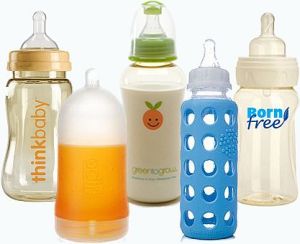One of the best parts of being pregnant is the time when you start buying everything your little one will need, clothes, changing tables, bottles, pacifiers, toys and many many more stuff, unnecessary sometimes. Well, in this time I began to learn a lot more about plastics, sure everybody knows the story about not heating plastic wrap in the microwave, but I did’nt even know why.
Now it’s quite obvious that some plastics have dangerous side effects, after all, 99 % of plastics come from “heavy petrol”, so many chemical processes are required to end with the plastics we love for making our lives more practical.
Going back to the baby basics the biggest no-no is definitely plastics containing BPA ( bisphenol-a) most commonly #7 plastic. Almost every baby bottle was made with this plastic a couple of years ago. While manufacturers argue that the everyday exposure to BPA is too small to cause any real health concerns, clinical studies are piling up linking BPA to breast cancer, testicular cancer, diabetes, hyperactivity, obesity, low sperm counts, miscarriage and a host of other reproductive failures in laboratory animals. It is also linked with immune system alterations, early puberty, developmental problems, insulin resistance, increased risk of type II diabetes, and hypertension. In short, most research suggests that BPA acts as an “environmental estrogen” and once it’s ingested it can disrupt proper hormone functioning, alter genes and interferes with normal physical and behavioral development.
In other words, avoid clear, hard plastic, also if its scratched or damaged it can leach double that of new plastics. Plastics without BPA are soft and cloudy colored. Nowadays almos all baby products label their plastics BPA-free, if you can’t find it, check for the number at the bottom, if you are not sure… don’t buy it! With my daughter I used Born Free baby bottles, but they are many other options available now, of course glass has never had problems.
Phtalates, abbreviated DEHP are industrial chemicals used in vinyl, PVC (to give its flexibility), solvents and synthetic fragances (perfumes) and are well known to be endocrine disruptors. Phthalates are relatively persistent in the environment and have been found in drinking water, soil, household dust, wildlife, fatty foods and in the blood and breast milk of humans and animals. Although phthalates are considered hazardous waste and regulated as air and water pollutants, they are unregulated in food, cosmetics, and consumer and medical products.
Shocking right!, but just read what are the side effects: high levels of phthalates have gender-bending effects on animals, specifically males, making them more feminine and leading to poor sperm quality and infertility. New studies suggest that even at normal levels, phthalates, which are ubiquitous, can disrupt the development of male babies’ reproductive organs. Additionally, in a September 2000 study, Puerto Rican researchers reported that phthalates had been detected in baby girls, aged 6 months to eight years, with premature breast development. The average levels of DEHP were six times greater in the early developers than in babies who had not experienced premature breast development. This same study showed phthalates adversely affected the male reproductive system in animals, inducing hypospadias, cryptorchidism, reduced testosterone production and decreased sperm counts. More recently Phthalates has been classified by the CDC as a probable human carcinogen and clinical studies show it causes chronic health problems, including liver and kidney abnormalities, asthma and skin and upper respiratory allergies. And this is just a VERY tiny bit of information.
Feeling overwhelmed? Yes, but the solution is simple, simply stop buying vinyl toys, to be sure, avoid buying plastic toys!!! Replace them with wood or fabric toys, silicone pacifiers or latex teethers. If it has a “new pastic smell” it has phtalates, and a big one, if its a big CHEAP toy, without any plastic specifications, random brand, made in china.. GOD! DON’T BUY IT!!!
These are examples of cool safe toys and a Soothie silicone pacifier.
To wrap this up, check for the number in plastics!
1 Polyethylene terephthalate (PET or PETE)
GOOD: Not known to leach any chemicals that are suspected of causing cancer or disrupting hormones.
2 High density polyethylene (HDPE)
GOOD: Not known to leach any chemicals that are suspected of causing cancer or disrupting hormones.
3 Polyvinyl chloride (V or PVC)
Most cling-wrapped meats, cheeses, and other foods sold in delicatessens and groceries are wrapped in PVC.
BAD: To soften into its flexible form, manufacturers add “plasticizers” during production. Traces of these chemicals can leach out of PVC when in contact with foods. According to the National Institutes of Health, di-2-ethylhexyl phthalate (DEHP), commonly found in PVC, is a suspected human carcinogen.
4 Low-density polyethylene (LDPE)
OK: Not known to leach any chemicals that are suspected of causing cancer or disrupting hormones, but not as widely recycled as #1 or #2.
5 Polypropylene (PP)
OK: Hazardous during production, but not known to leach any chemicals that are suspected of causing cancer or disrupting hormones. Not as widely recycled as #1 and #2.
6 Polystyrene (PS)
Foam insulation and also for hard applications (e.g. cups, some toys)
BAD: Benzene (material used in production) is a known human carcinogen. Butadiene and styrene (the basic building block of the plastic) are suspected carcinogens. Energy intensive and poor recycling.
7 Other (usually polycarbonate)
Baby bottles, microwave ovenware, eating utensils, plastic coating for metal cans
BAD: Made with biphenyl-A, a hormone disruptor. Can leach into food as product ages.
Now you know why it’s not safe to put plastics in the microwave!
Don’t forget to subscribe!
xx


